Analyzing St. Luke's Health Care System: Wireless Network Security
VerifiedAdded on 2023/06/15
|5
|991
|451
Case Study
AI Summary
This case study examines St. Luke's Health Care System's utilization of wireless technologies, focusing on the benefits of Mobility XE, security mechanisms in compliance with HIPAA requirements, and the use of VLANs. The analysis highlights the advantages of Mobility XE in providing constant network access, supporting bandwidth-intensive applications, and ensuring secure connections. It further elaborates on HIPAA's Administrative, Physical, and Technical Safeguards necessary for healthcare data protection, emphasizing risk analysis, security officer selection, and policy updates. Finally, the case study discusses the benefits of VLANs in enhancing network functionality, security, and performance within the hospital environment, particularly in reducing maintenance costs and downtime while improving data security. The real time evaluation of healthcare applications is necessary to increase security interface from data being altered or hacked in St. Luke’s Health Care System.
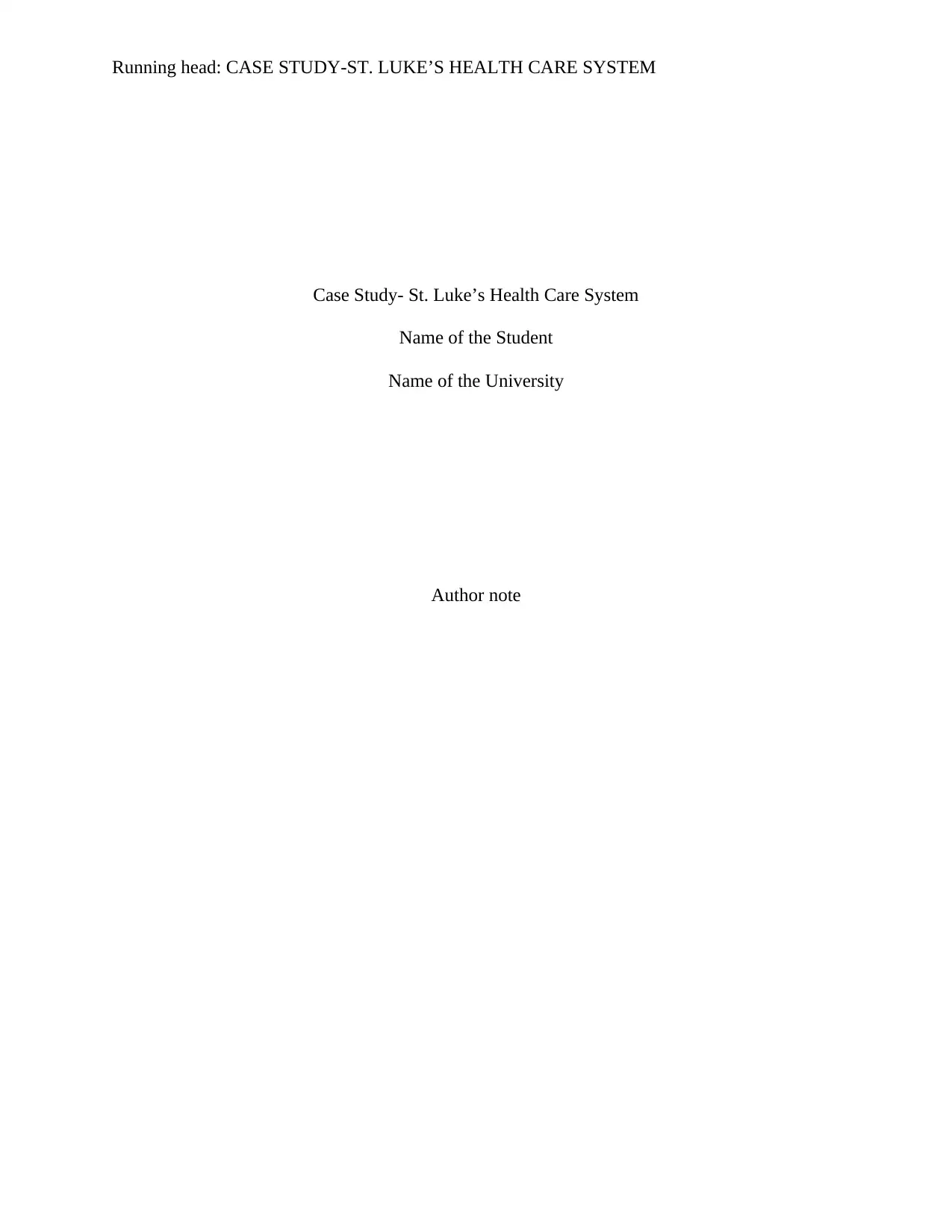
Running head: CASE STUDY-ST. LUKE’S HEALTH CARE SYSTEM
Case Study- St. Luke’s Health Care System
Name of the Student
Name of the University
Author note
Case Study- St. Luke’s Health Care System
Name of the Student
Name of the University
Author note
Paraphrase This Document
Need a fresh take? Get an instant paraphrase of this document with our AI Paraphraser
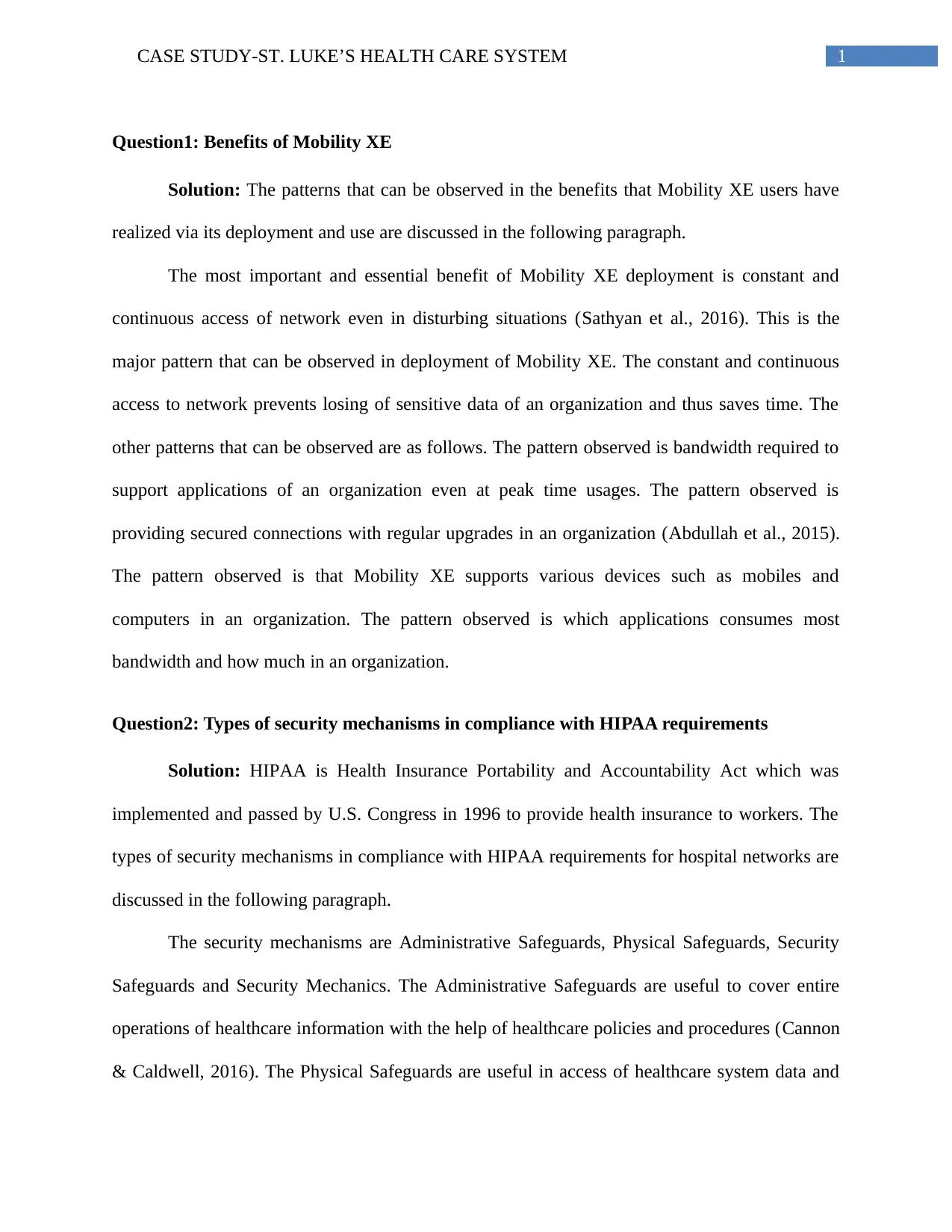
1CASE STUDY-ST. LUKE’S HEALTH CARE SYSTEM
Question1: Benefits of Mobility XE
Solution: The patterns that can be observed in the benefits that Mobility XE users have
realized via its deployment and use are discussed in the following paragraph.
The most important and essential benefit of Mobility XE deployment is constant and
continuous access of network even in disturbing situations (Sathyan et al., 2016). This is the
major pattern that can be observed in deployment of Mobility XE. The constant and continuous
access to network prevents losing of sensitive data of an organization and thus saves time. The
other patterns that can be observed are as follows. The pattern observed is bandwidth required to
support applications of an organization even at peak time usages. The pattern observed is
providing secured connections with regular upgrades in an organization (Abdullah et al., 2015).
The pattern observed is that Mobility XE supports various devices such as mobiles and
computers in an organization. The pattern observed is which applications consumes most
bandwidth and how much in an organization.
Question2: Types of security mechanisms in compliance with HIPAA requirements
Solution: HIPAA is Health Insurance Portability and Accountability Act which was
implemented and passed by U.S. Congress in 1996 to provide health insurance to workers. The
types of security mechanisms in compliance with HIPAA requirements for hospital networks are
discussed in the following paragraph.
The security mechanisms are Administrative Safeguards, Physical Safeguards, Security
Safeguards and Security Mechanics. The Administrative Safeguards are useful to cover entire
operations of healthcare information with the help of healthcare policies and procedures (Cannon
& Caldwell, 2016). The Physical Safeguards are useful in access of healthcare system data and
Question1: Benefits of Mobility XE
Solution: The patterns that can be observed in the benefits that Mobility XE users have
realized via its deployment and use are discussed in the following paragraph.
The most important and essential benefit of Mobility XE deployment is constant and
continuous access of network even in disturbing situations (Sathyan et al., 2016). This is the
major pattern that can be observed in deployment of Mobility XE. The constant and continuous
access to network prevents losing of sensitive data of an organization and thus saves time. The
other patterns that can be observed are as follows. The pattern observed is bandwidth required to
support applications of an organization even at peak time usages. The pattern observed is
providing secured connections with regular upgrades in an organization (Abdullah et al., 2015).
The pattern observed is that Mobility XE supports various devices such as mobiles and
computers in an organization. The pattern observed is which applications consumes most
bandwidth and how much in an organization.
Question2: Types of security mechanisms in compliance with HIPAA requirements
Solution: HIPAA is Health Insurance Portability and Accountability Act which was
implemented and passed by U.S. Congress in 1996 to provide health insurance to workers. The
types of security mechanisms in compliance with HIPAA requirements for hospital networks are
discussed in the following paragraph.
The security mechanisms are Administrative Safeguards, Physical Safeguards, Security
Safeguards and Security Mechanics. The Administrative Safeguards are useful to cover entire
operations of healthcare information with the help of healthcare policies and procedures (Cannon
& Caldwell, 2016). The Physical Safeguards are useful in access of healthcare system data and
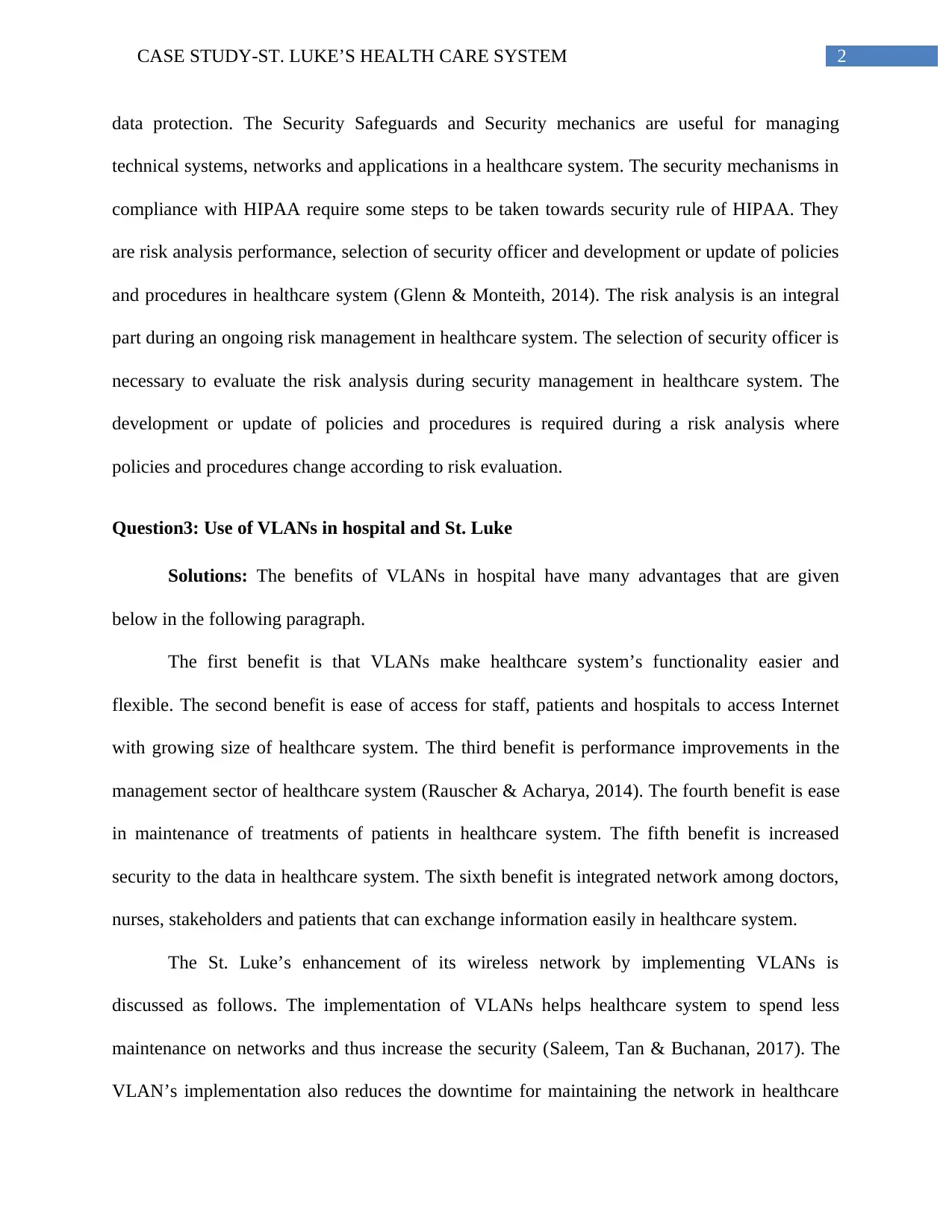
2CASE STUDY-ST. LUKE’S HEALTH CARE SYSTEM
data protection. The Security Safeguards and Security mechanics are useful for managing
technical systems, networks and applications in a healthcare system. The security mechanisms in
compliance with HIPAA require some steps to be taken towards security rule of HIPAA. They
are risk analysis performance, selection of security officer and development or update of policies
and procedures in healthcare system (Glenn & Monteith, 2014). The risk analysis is an integral
part during an ongoing risk management in healthcare system. The selection of security officer is
necessary to evaluate the risk analysis during security management in healthcare system. The
development or update of policies and procedures is required during a risk analysis where
policies and procedures change according to risk evaluation.
Question3: Use of VLANs in hospital and St. Luke
Solutions: The benefits of VLANs in hospital have many advantages that are given
below in the following paragraph.
The first benefit is that VLANs make healthcare system’s functionality easier and
flexible. The second benefit is ease of access for staff, patients and hospitals to access Internet
with growing size of healthcare system. The third benefit is performance improvements in the
management sector of healthcare system (Rauscher & Acharya, 2014). The fourth benefit is ease
in maintenance of treatments of patients in healthcare system. The fifth benefit is increased
security to the data in healthcare system. The sixth benefit is integrated network among doctors,
nurses, stakeholders and patients that can exchange information easily in healthcare system.
The St. Luke’s enhancement of its wireless network by implementing VLANs is
discussed as follows. The implementation of VLANs helps healthcare system to spend less
maintenance on networks and thus increase the security (Saleem, Tan & Buchanan, 2017). The
VLAN’s implementation also reduces the downtime for maintaining the network in healthcare
data protection. The Security Safeguards and Security mechanics are useful for managing
technical systems, networks and applications in a healthcare system. The security mechanisms in
compliance with HIPAA require some steps to be taken towards security rule of HIPAA. They
are risk analysis performance, selection of security officer and development or update of policies
and procedures in healthcare system (Glenn & Monteith, 2014). The risk analysis is an integral
part during an ongoing risk management in healthcare system. The selection of security officer is
necessary to evaluate the risk analysis during security management in healthcare system. The
development or update of policies and procedures is required during a risk analysis where
policies and procedures change according to risk evaluation.
Question3: Use of VLANs in hospital and St. Luke
Solutions: The benefits of VLANs in hospital have many advantages that are given
below in the following paragraph.
The first benefit is that VLANs make healthcare system’s functionality easier and
flexible. The second benefit is ease of access for staff, patients and hospitals to access Internet
with growing size of healthcare system. The third benefit is performance improvements in the
management sector of healthcare system (Rauscher & Acharya, 2014). The fourth benefit is ease
in maintenance of treatments of patients in healthcare system. The fifth benefit is increased
security to the data in healthcare system. The sixth benefit is integrated network among doctors,
nurses, stakeholders and patients that can exchange information easily in healthcare system.
The St. Luke’s enhancement of its wireless network by implementing VLANs is
discussed as follows. The implementation of VLANs helps healthcare system to spend less
maintenance on networks and thus increase the security (Saleem, Tan & Buchanan, 2017). The
VLAN’s implementation also reduces the downtime for maintaining the network in healthcare
⊘ This is a preview!⊘
Do you want full access?
Subscribe today to unlock all pages.

Trusted by 1+ million students worldwide
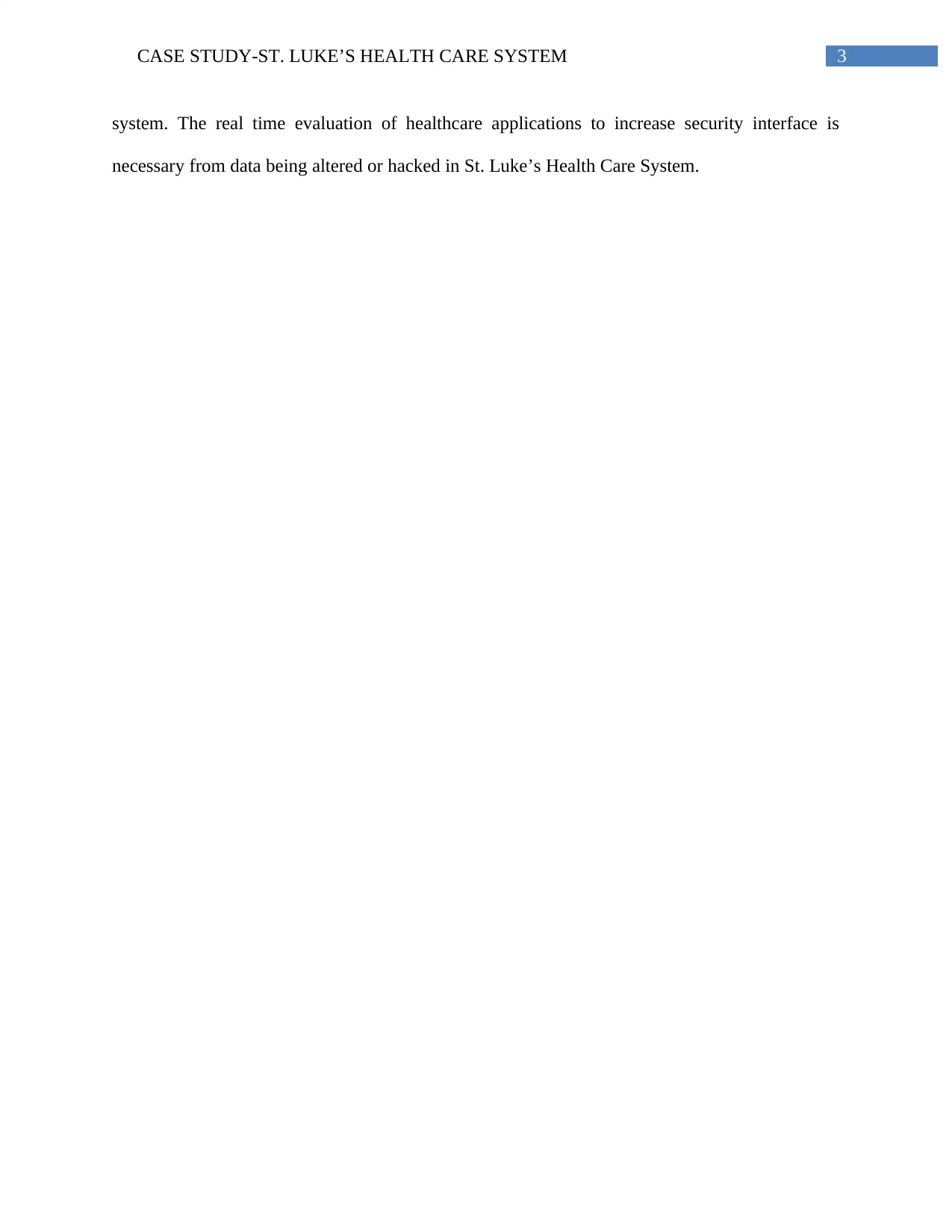
3CASE STUDY-ST. LUKE’S HEALTH CARE SYSTEM
system. The real time evaluation of healthcare applications to increase security interface is
necessary from data being altered or hacked in St. Luke’s Health Care System.
system. The real time evaluation of healthcare applications to increase security interface is
necessary from data being altered or hacked in St. Luke’s Health Care System.
Paraphrase This Document
Need a fresh take? Get an instant paraphrase of this document with our AI Paraphraser
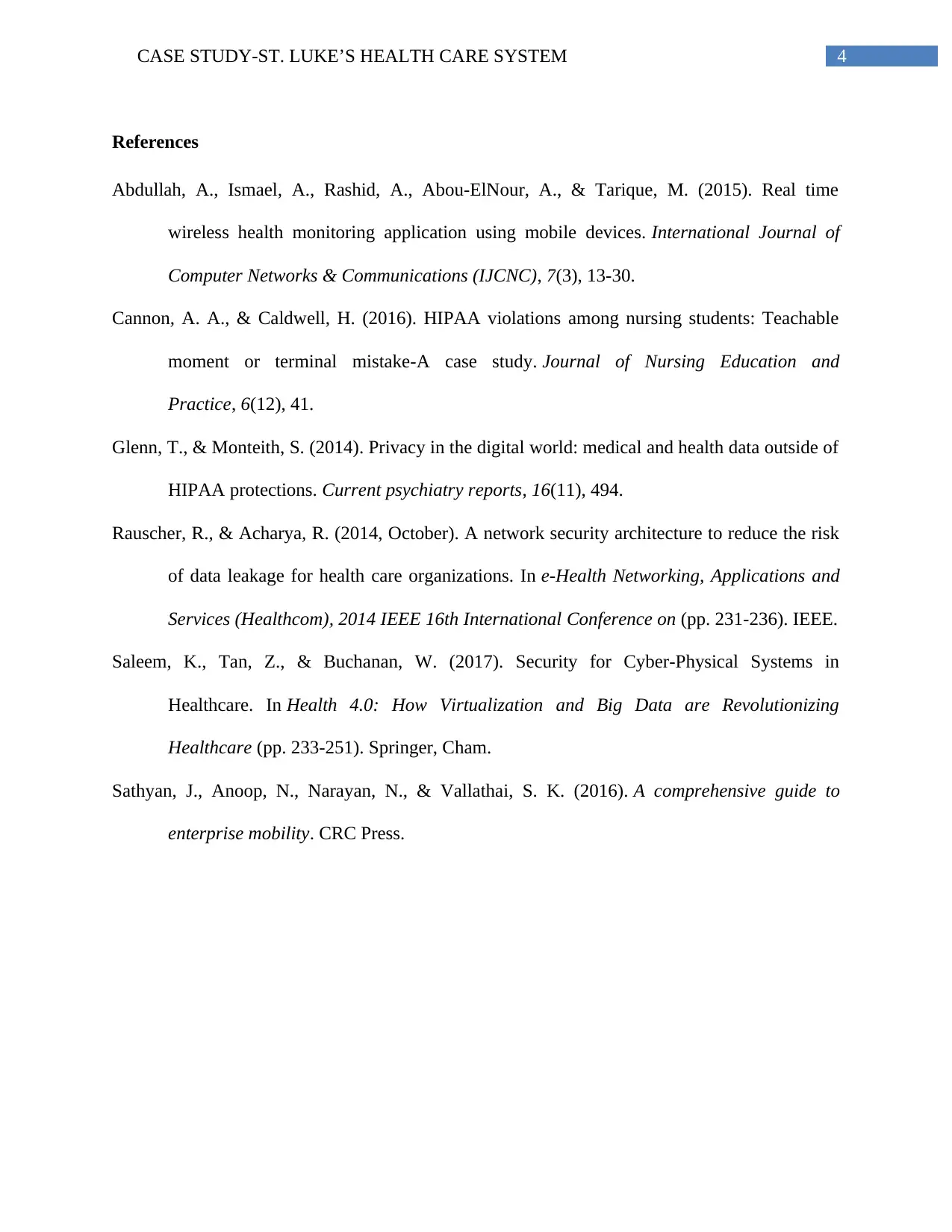
4CASE STUDY-ST. LUKE’S HEALTH CARE SYSTEM
References
Abdullah, A., Ismael, A., Rashid, A., Abou-ElNour, A., & Tarique, M. (2015). Real time
wireless health monitoring application using mobile devices. International Journal of
Computer Networks & Communications (IJCNC), 7(3), 13-30.
Cannon, A. A., & Caldwell, H. (2016). HIPAA violations among nursing students: Teachable
moment or terminal mistake-A case study. Journal of Nursing Education and
Practice, 6(12), 41.
Glenn, T., & Monteith, S. (2014). Privacy in the digital world: medical and health data outside of
HIPAA protections. Current psychiatry reports, 16(11), 494.
Rauscher, R., & Acharya, R. (2014, October). A network security architecture to reduce the risk
of data leakage for health care organizations. In e-Health Networking, Applications and
Services (Healthcom), 2014 IEEE 16th International Conference on (pp. 231-236). IEEE.
Saleem, K., Tan, Z., & Buchanan, W. (2017). Security for Cyber-Physical Systems in
Healthcare. In Health 4.0: How Virtualization and Big Data are Revolutionizing
Healthcare (pp. 233-251). Springer, Cham.
Sathyan, J., Anoop, N., Narayan, N., & Vallathai, S. K. (2016). A comprehensive guide to
enterprise mobility. CRC Press.
References
Abdullah, A., Ismael, A., Rashid, A., Abou-ElNour, A., & Tarique, M. (2015). Real time
wireless health monitoring application using mobile devices. International Journal of
Computer Networks & Communications (IJCNC), 7(3), 13-30.
Cannon, A. A., & Caldwell, H. (2016). HIPAA violations among nursing students: Teachable
moment or terminal mistake-A case study. Journal of Nursing Education and
Practice, 6(12), 41.
Glenn, T., & Monteith, S. (2014). Privacy in the digital world: medical and health data outside of
HIPAA protections. Current psychiatry reports, 16(11), 494.
Rauscher, R., & Acharya, R. (2014, October). A network security architecture to reduce the risk
of data leakage for health care organizations. In e-Health Networking, Applications and
Services (Healthcom), 2014 IEEE 16th International Conference on (pp. 231-236). IEEE.
Saleem, K., Tan, Z., & Buchanan, W. (2017). Security for Cyber-Physical Systems in
Healthcare. In Health 4.0: How Virtualization and Big Data are Revolutionizing
Healthcare (pp. 233-251). Springer, Cham.
Sathyan, J., Anoop, N., Narayan, N., & Vallathai, S. K. (2016). A comprehensive guide to
enterprise mobility. CRC Press.
1 out of 5
Related Documents
Your All-in-One AI-Powered Toolkit for Academic Success.
+13062052269
info@desklib.com
Available 24*7 on WhatsApp / Email
![[object Object]](/_next/static/media/star-bottom.7253800d.svg)
Unlock your academic potential
Copyright © 2020–2025 A2Z Services. All Rights Reserved. Developed and managed by ZUCOL.





